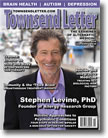Page 1, 2
Identifying Trauma in Patients
In my experience, identifying a history of psychological trauma or PTSD in patients is not difficult. Patients often volunteer information about their trauma history if they believe that it is related to their condition. Indeed, many have been trying to get doctors to take their trauma history seriously for years. Others will not volunteer but will answer honestly when asked. I have encountered relatively few patients with strong evidence of autonomic dysregulation who deny having a trauma history. Often a simple question such as, have you had any major stresses or traumatic experiences in your adult life? What about your childhood? is sufficient to start a conversation. In addition, standardized questionnaires, such as the PTSD Checklist can be used.44 There are no laboratory measures that are exclusively associated with posttraumatic stress; however, diurnal cortisol rhythm and heart rate variability studies will often be abnormal.45-47 In my opinion, assessing the possibility of posttraumatic stress is warranted in any patient with strong evidence of autonomic dysregulation, or with any condition or risk-associated behaviors that have a strong correlation with psychological trauma.
Healing Trauma
The dominant psychotherapeutic approaches in use today for PTSD are cognitive behavioral therapy (CBT) and eye movement desensitization and reprocessing (EMDR). CBT is the most common form of "talk therapy" in use by psychotherapists, and while it is generally considered effective, research has shown nonresponse rates of up to 50% in recipients with PTSD. Poor response has been associated with deficits in verbal memory, anxiety, and greater amygdala and ventral anterior cingulate activation.48 All of these are quite common in patients with PTSD.
EMDR involves holding a traumatic memory in mind while the therapist provides some form of bilateral sensory stimulation, originally the movement of a finger back and forth in front of the client's eyes. The client then follows the train of images, thoughts, and emotions that emerge as the therapist continues to apply bilateral stimulation. Although here have been anecdotal reports of rapid improvement of PTSD symptoms in some patients, comparative research has consistently shown EMDR to be no more effective than CBT in the treatment of PTSD.49,50 Bessel van der Kolk, a prominent PTSD researcher and clinician, asserts that EMDR works well for specific, emotionally charged memories, but not for complex forms of childhood maltreatment.51 This may explain the discrepancy between anecdotal reports and research outcomes.
While CBT and EMDR are certainly helpful, it is unclear to what degree they actually alter the physiological dysregulation underlying trauma, a key question from a medical standpoint. The majority of studies examining CBT and EMDR have used psychological measures, such as scores on PTSD rating scales and quality-of-life questionnaires as their endpoints. Having seen many patients who had undergone psychotherapy prior to seeing me, my personal impression is that psychotherapy, as it is generally practiced, results in only modest improvements in physiological self-regulation. For those who do not respond well to conventional psychotherapy, there are, thankfully, a number of alternative therapies that show promise.
Several somatically based therapies have been developed for the treatment of psychoemotional trauma. These include Somatic Experiencing, Sensorimotor Psychotherapy and Self Regulation Therapy. These therapies currently lack validation by clinical trials; however, unlike CBT and EMDR, they are modeled more directly on current scientific understanding of the neurophysiology of trauma. The common goal of these therapies is to assist patients in completing thwarted defensive responses which appear to remain encoded cortically and subcortically as part of the patient's trauma associated procedural memory.52 Because CNS-autonomic arousal is perceptible as sensations in the body, these therapies use mindful awareness of somatic sensations as a guide to identifying and completing neurological and motor defensive responses.53,54 I use Self Regulation Therapy in my practice and find that it often has a dramatic effect on hyperarousal symptoms such as emotional reactivity to stress, startle response, and sleep disturbances.
Several forms of biofeedback have been used in PTSD. Neurofeedback, also known as EEG biofeedback, uses computer-generated real-time feedback of brain activity to teach self regulation. Several studies have shown positive effects in PTSD, including improved cortical and subcortical connectivity and substantial improvements in PTSD symptoms over time.55-57 Studies have also shown improvements in a number of somatic conditions strongly associated with autonomic dysregulation and traumatic stress, including insomnia, fibromyalgia, and migraine headaches.58-60 Heart rate variability biofeedback has also been shown to improve self-regulation in veterans with PTSD.61
The use of meditation for the treatment of posttraumatic stress has been fairly well studied. A number of types of meditation have been examined, including Sudarshan Kriya Yoga, loving-kindness meditation, mindfulness meditation, and Transcendental Meditation (TM).62,63 All forms of meditation studied have shown positive results. Perhaps the most striking results to date were demonstrated in a two-arm study of TM involving 73 Congolese refugees with PTSD. Scores on the PTSD Checklist (PCL-C) were reduced by over 50% at 30 days in those practicing TM and remained low for the remainder of the study, while scores for those not meditating actually increased slightly.64 Another study of TM showed increased activity in the medial prefrontal cortex, while a study of mindfulness meditation showed decreased activity in the amygdala of adults exposed to stress.65,66 Both of these neuroplastic changes are consistent with improved self-regulation.
Conclusion
Self-regulation is one of the fundamental functions of the central nervous system and is essential for long-term health. Psychoemotional trauma is a common source of chronic dysregulation and plays a significant role in the morbidity seen daily in most medical offices, not to mention its profound contribution to psychological suffering. While the concept of self-regulation and its association to trauma may be new to some alternative physicians, most are already treating dysregulation via such therapies as balancing neurotransmitters, hormones, and the HPA axis. For patients with significant trauma, however, standard alternative therapies may not be enough. Providing or referring patients for therapies that address the physiopathology of trauma more directly may have a substantial impact on their recovery. Furthermore, some therapies that help to restore neurological self-regulation, such as neurofeedback, heart rate variability biofeedback, and meditation training, can be fairly easily integrated into many alternative medical practices. Lastly, for many patients, the simple matter of having a doctor who actually understands what they've been through and how it is affecting them will have a healing power in itself.
Page 1, 2
Notes .pdf
 Sandro D'Amico holds a BA in psychology from the Union Institute & University, where his studies emphasized the influence of psychological factors on health and illness. He received his doctor of naturopathic medicine degree from Southwest College of Naturopathic Medicine in 2002, where he also completed his residency. Dr. D'Amico's long-held fascination with psychophysiology led him to specialize in the treatment of mental health conditions using alternative therapies. In addition to his standard naturopathic training, his postgraduate studies have included 2 years of study at the Canadian Foundation for Trauma Research and Education and extensive study and research into the use of nutritional therapies in mental health. He currently lives and practices with his wife, Dr. Greta D'Amico, in Auburn, California. Sandro D'Amico holds a BA in psychology from the Union Institute & University, where his studies emphasized the influence of psychological factors on health and illness. He received his doctor of naturopathic medicine degree from Southwest College of Naturopathic Medicine in 2002, where he also completed his residency. Dr. D'Amico's long-held fascination with psychophysiology led him to specialize in the treatment of mental health conditions using alternative therapies. In addition to his standard naturopathic training, his postgraduate studies have included 2 years of study at the Canadian Foundation for Trauma Research and Education and extensive study and research into the use of nutritional therapies in mental health. He currently lives and practices with his wife, Dr. Greta D'Amico, in Auburn, California.
|
![]()
![]()
![]()





 Sandro D'Amico holds a BA in psychology from the Union Institute & University, where his studies emphasized the influence of psychological factors on health and illness. He received his doctor of naturopathic medicine degree from Southwest College of Naturopathic Medicine in 2002, where he also completed his residency. Dr. D'Amico's long-held fascination with psychophysiology led him to specialize in the treatment of mental health conditions using alternative therapies. In addition to his standard naturopathic training, his postgraduate studies have included 2 years of study at the Canadian Foundation for Trauma Research and Education and extensive study and research into the use of nutritional therapies in mental health. He currently lives and practices with his wife, Dr. Greta D'Amico, in Auburn, California.
Sandro D'Amico holds a BA in psychology from the Union Institute & University, where his studies emphasized the influence of psychological factors on health and illness. He received his doctor of naturopathic medicine degree from Southwest College of Naturopathic Medicine in 2002, where he also completed his residency. Dr. D'Amico's long-held fascination with psychophysiology led him to specialize in the treatment of mental health conditions using alternative therapies. In addition to his standard naturopathic training, his postgraduate studies have included 2 years of study at the Canadian Foundation for Trauma Research and Education and extensive study and research into the use of nutritional therapies in mental health. He currently lives and practices with his wife, Dr. Greta D'Amico, in Auburn, California.